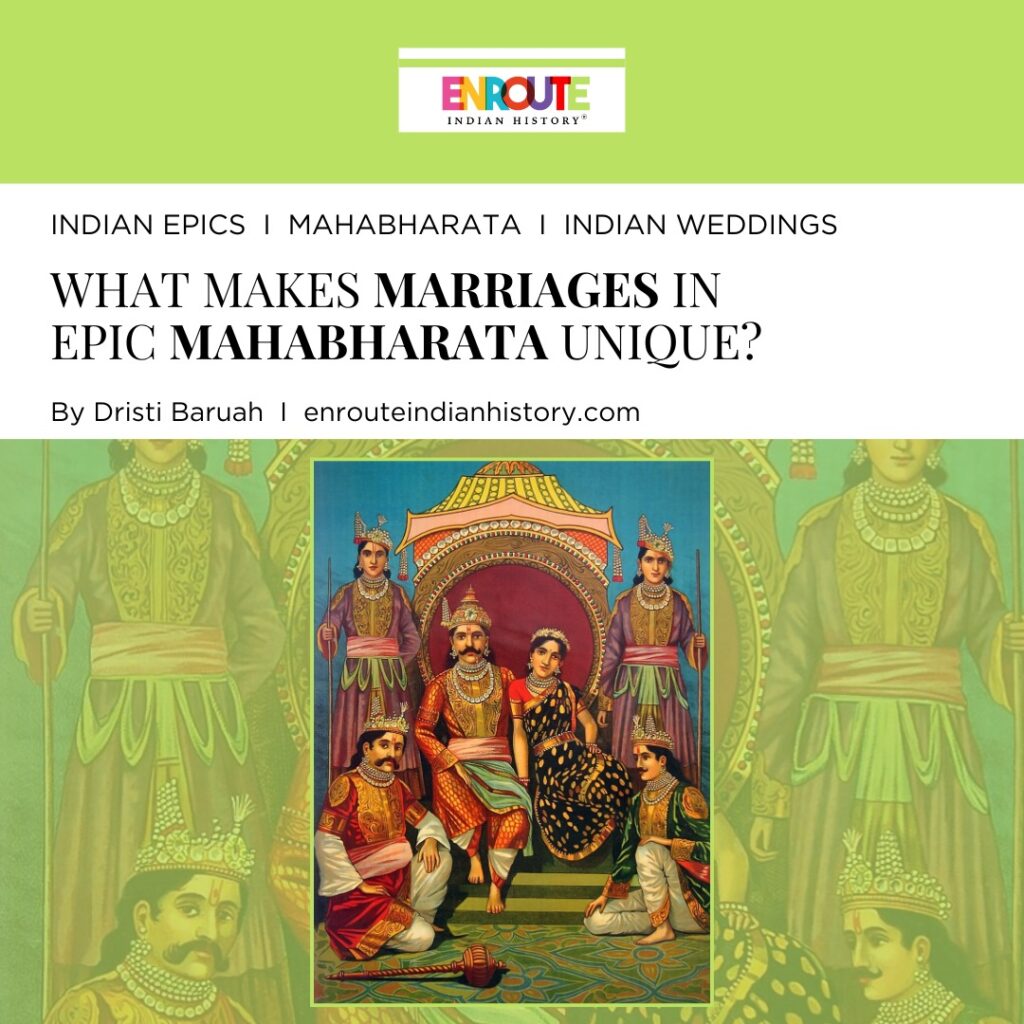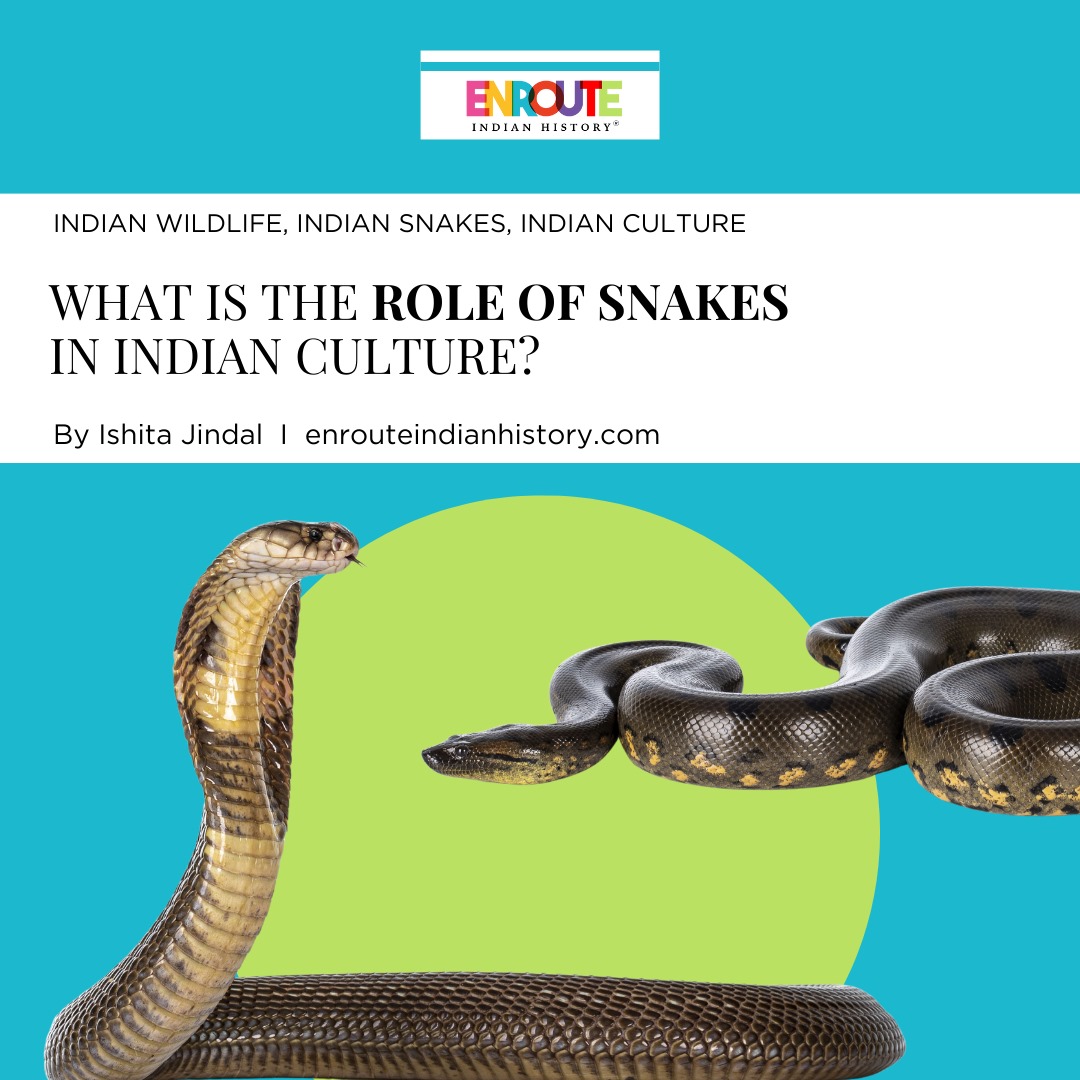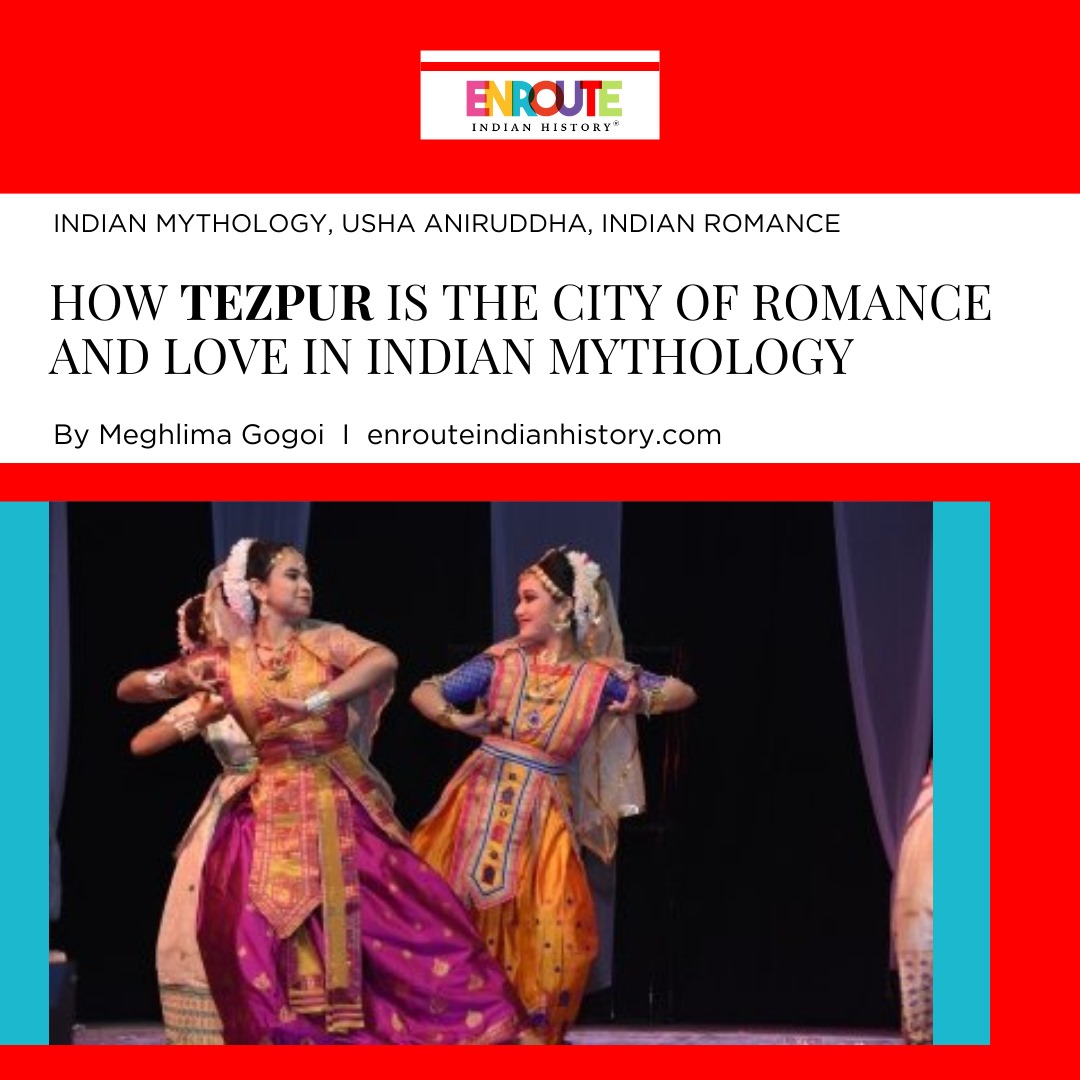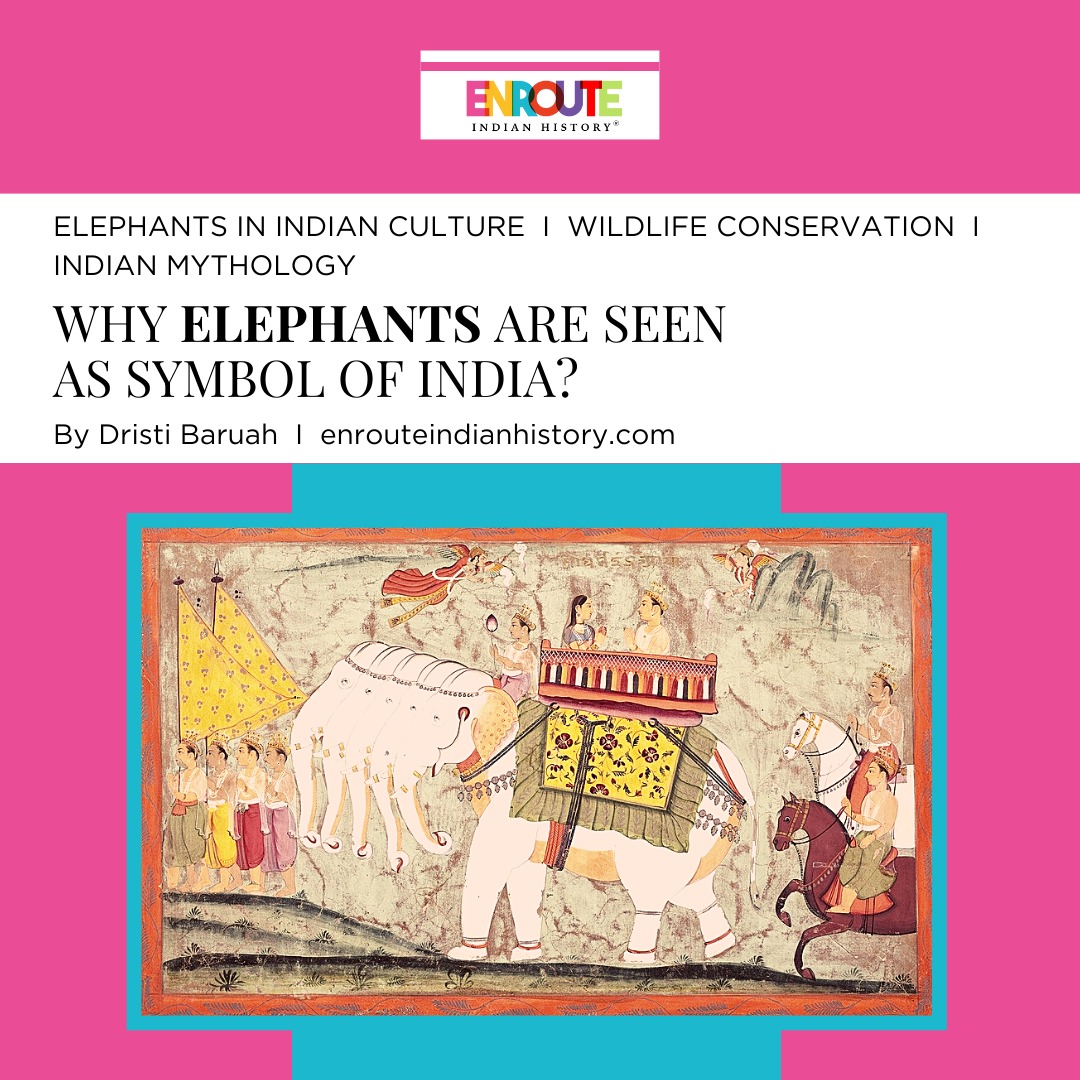
Mahabharat is a very integral part of Indian culture as a whole. Intricate plot design, beautiful poetic language and socio-religious importance all make it one of the defining tales of Indian literary tradition. The characters of Mahabharata are incredibly compelling, be it male or female characters. A multitude of powerful, wise, and feminine characters, such as Draupadi, Kunti, and Gandhari, are featured throughout the epic and leave a lasting impression on readers. And one thing to note is that many of the women characters in the epic become vital to the story via their marriages.
Social components like parenthood, marriage, and sexuality all in some way support a connection streedharma or women’s dharma for the women characters. The code of conduct for women in that era was formulated with the assistance of the symbiotic interaction between sexuality, marriage, and streedharma. So it becomes somewhat important to understand what kind of role was played by the women in their marriages; questions such as agency exercised within the marriage, goals achieved and consent to the marriages in the first place are natural questions to be asked by a reader.
Punishment for agency

Ganga being interrupted by Shantanu
We can try to understand such questions by taking a look at some individual women characters from the epic. Mahabharata has many characters which exemplify the role of an ideal wife, it also has many layers of subversion of this trope. The first important manifestation of this is in the form Ganga. The descendant of King Bharata and supreme ruler of Kuru dynasty, Shantanu married the beautiful river goddess but this was not a regular wedding. Hidden in conditions of partnership was the Ganga’s quiet exercise of secret agency, thwarting the normative feminine role she was supposed to play as a wife and as a mother. Her shocking actions paralyzed her husband who had perhaps never seen a woman who was so willing to callously drown almost seven of her children. But Ganga is not perceived well even after her explanation to Shantanu. Her authority violates the norms of a wife and mother and it creates tension. A tension which is only solved when she rewards Shantanu with a charismatic and talented son such as Devavrat. But what if she had not offered Shantanu the son? What if she had not been given a redeeming character arc? It is this tension that reveals to us our own deep seated beliefs of what a woman should be, brushing entire womankind with a single stroke of paint. Any violation of the norm can only be punished, and in Ganga’s case, it was the necessity for her exit from the focus of story after the role of an heir producer had been finished.

Shantanu and Matsyagandha Satyavati
And while Ganga was an antithesis to the traditional role of a mother, Satyavati, her daughter in law, was a diametrically opposite character whose ambitions influenced her decisions as a mother as well. She too, much like Ganga, poses conditions of marriage in front of Shantanu but she takes a different approach by trying to ensure that it is her scions who take the throne, removing even the rightful heir in the process. But Satyavati’s ambitions are not fulfilled the way she would have wanted. In fact it is said that it is her unrelenting and unending need for prestige and glory that sows the seeds for the central conflict of Mahabharata. Her ambitions are not just lofty goals but they are marked by an impression of self importance. Her practice of free sexuality is a cause of pain for her daughters in law in the future. The numerous adaptations of Mahabharata in film and media concentrate on this aspect of hers heavily. Satyavati doesn’t die a happy woman, submitting herself to austerity for penance.

Bhisma’s terrible oath
A similar disillusionment with the existing tradition was written in the fate of the third sister Amba. The princess tells Bhishma that she is in love with King Salva before her wedding to Satyavati’s son Vichitravirya, and he grants her permission to approach him and ask him to accept her as his wife. She is shocked to learn that Salva rejects her since he believes Bhishma has always accepted her as his wife. Bhishma declines to wed her due to his oath in spite of her and Parashurama’s best attempts. She is deprived of her right to be respected as an individual as well as her honour as royal. She is left and abandoned. Her plight was so dire that even Parashurama’s intervention could not make any king ever accept her, including Bhishma. These episodes reveal to us the strict lines of conduct for women and the thin lines of morality for men.
Control of sexuality
It is through Satyavati’s decisions we are able to look at “niyoga pratha,” where a wife gets her husband’s consent to conceive a child using another man’s seed although only in cases where the husband is dead, infertile, or otherwise unable to produce an inheritor. Although it appears that doing “niyoga” violates one’s ethical duty of sexual fidelity to one’s spouse and chastity is called into doubt, the Mahabharata presents the “niyoga” as a unique system of reproductivity and the practice of streedharma with a nuanced, pragmatic political viewpoint.
But ambitions do not always bring fruit. Satyavati’s insistence on the continuation of her lineage clashes with the desires of the women who she requires to fulfil the niyog pratha. Sisters Ambika and Ambalika are women who are brought into the court of Hastinapur by Bhishma without being afforded the due agency promised in the swayamvar process. With Satyavati’s approval, Vyasa, the famed sage, carried out the niyog pratha with Ambika and Ambalika, respectively. Regretfully, though, Ambika and Ambalika were unable to choose their partners. The ultimate decision in their lives was Satyavati and Bhisma’s joint choice. They were forced to consummate with the obnoxious and ugly brother-in-law Vyasa by the nuptial family, and as a result, they had to bear blind and discoloured sons who would be cursed twice for their personal and matrilineal shortcomings.

Kunti and Pandu
In the event of the birth of Pandavas, we can see Kunti is at first not prepared to include herself in it, yet later, brought about by Pandu’s enlightening request that eventually turned into a vile assertion that a spouse who is guided by her better half to sire an heir and yet denies, will cause a similar shrewd as one who aborts her child. Kunti, due to her husband’s inability to bear children, she must deal with the similar situation to Ambika and Ambalika in her marriage to King Pandu. She extracts the three divine sons—from Vayu, Indra, and Dharma— with his approval.
The Mahabharata portrays a vague picture of female sexuality. On the one hand, it is glorified and exploited; on the other hand, it is risky and possibly wicked. This makes clear the connection between women, sex and the female corpus mechanism. Female sexuality thus demonstrates both its potent and perilous characteristics in addition to its fertility and capacity to bear life. Male sexuality in the Mahabharata is never regimented; instead, it encourages unrestricted man-woman mingling. The husband however can manipulate a woman’s choice of partner and means of reproduction, perpetuating patriarchal control over her sexuality. Female sexuality however is viewed as a component of streedharma, or pativrata dharma. According to the streedharma/pativrata doctrine, women are psychologically controlled through their sexuality. In Vedic literature, the adjective “pativrata” refers to a lady who is sexually faithful to her husband. The lady herself accepts her passion as it tamed, shapes, and bent in one way. It is a boundary that you have set for yourself to internalise the decorum needed to keep your house quiet. It’s a means of monitoring her psycho-somatic life movements. The willful hush against it as it produces societal disgrace as well as the threat of a wife’s psychological instability.
Compromise as duty
In this epic, the practice of polygamy almost becomes a social norm. In that society, having more than one wife was both morally and legally acceptable. Because of this, practising polygamy can lead to a great deal of extended family bonds, which can serve to lessen rivalry among the rulers. Once more, there was a strong emphasis on sons maintaining the lineage intact during those times. In this sense, if an individual does not have a son from their first marriage, there is a good chance that they will reproduce in the following generation, therefore perpetuating the paternal lineage through polygamous marriage. In order to satisfy the political and generational causes, we may see the numerous references to polygamy in the situations of Pandu, Arjuna, Krishna, and Bhima. Surprisingly though, Draupadi’s marriage provides us with only one instance of polyandry.

Draupadi and her five husbands
Draupadi’s marriage however is enough to tell us the dynamics of control exercized over women, even one as strong as Draupadi. On characterizing the streedharma of Mahabharata the discussion among Draupadi and Satyabhama implies a great deal. Posing by the inquiry about how to keep the warmth and submission of her significant other she focuses on that her techniques for activities in managing the matter of family mostly founded on honesty, no sort of spell by any stretch of the imagination. The subservient mentality of Draupadi and her absolute dedication to pativrata as she says “to live under spouse’s insurance is the sanatana dharma for ladies. Spouse is god, he is salvation for ladies and he is the main asylum”. In her homegrown errands, she generally likes to do her own exercises like washing, eating and resting after her spouses and keeps up with submission at the hour of talking. In reality, Draupadi’s regal upbringing shows her the fundamental power dynamics among people.

Draupadi’s humiliation in the Kuru court
Even as Draupadi questions her eldest husband’s right to wager her even after losing herself in the Dyuta Sabha, we see her inclination to forgive her husbands for their inability to protect her honor.
Regarding matrimony, the poet additionally draws attention to the epical perspective regarding the Mahabharata’s interfaith marriage system. The author’s inventiveness is demonstrated by the interfaith unions of Bhima and Hirimba and Arjuna and Ulupi. Hirimba and Ulupi, the respective brides, are serpents by origin and rakshas by origination. They differ, therefore, not in terms of look, but rather in terms of culture, creed, habit, and customs. It’s true that cultural background plays a big role in marriage. Therefore, there may be certain misconceptions about these Mahabharata intersecting marriages. However, a closer examination of these marriages supports the fundamental notion of femininity.
For instance, while being a “rakshas joni” figure, Hirimba’s eternal feminine essence and her devotion to her spouse Bhima have greater power than rakshasi traits. Her essence supports the idea that a woman’s dharma entails changing the role of feminine energy. In streedharma, Hirimba might be considered the epic’s famous wife. She will only get one chance in her lifetime to spend a few days with Bhima indulging in the pleasures of marriage. After then, with the birth of their son Ghatotkacha, she is required by the preconditions of marriage to leave him permanently right away. She can only survive by living in the past, travelling down memory lane, and waiting forever. She will be remembered in the Mahabharata for her selfless and devoted nature.
We understand from this article some of the roles assigned to women and how they function out in their marriages.
References
- Biswas, P. (2016). Interconnectivity of Marriage, Sexuality and Streedharma: Reflections through the Minor Female Characters of the Mahabharata. Bharatiya Pragna: An Interdisciplinary Journal of Indian Studies, 1(3).
- Sarker, P. B. (2016). Gender Relationships in The Mahabharata.
- Kang, M. (2015). The making of womanhood in early India: Pativrata in the Mahabharata and Ramayana
Image source
- Lacma foundation
- Firstpost
- Fine Art America
- Google Arts and Culture
- Wikipedia (public domain painting)
- Tallenge store
- February 16, 2024
- 8 Min Read

























